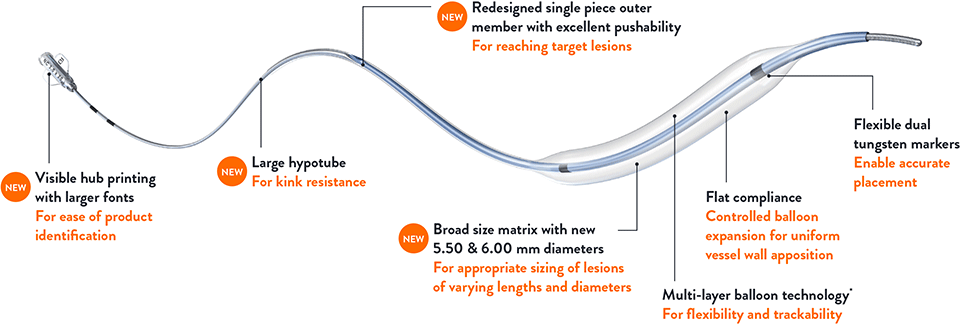
New 5.50 & 6.00 mm diameters
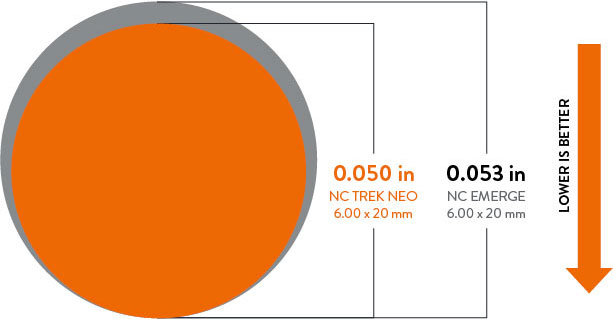
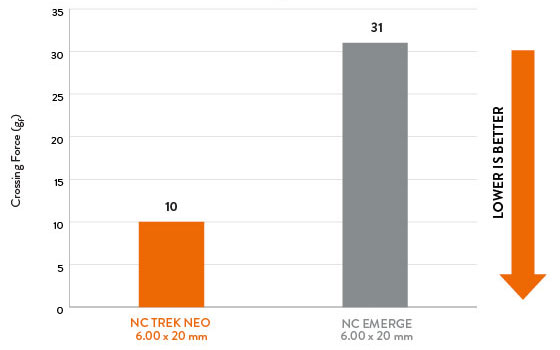
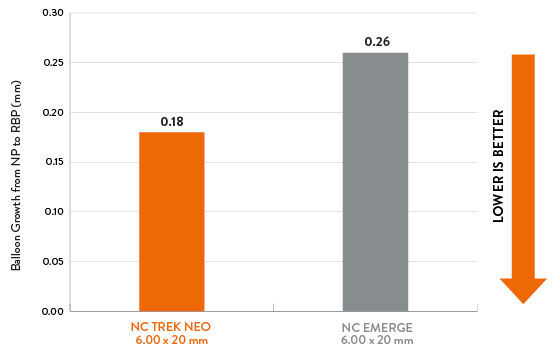
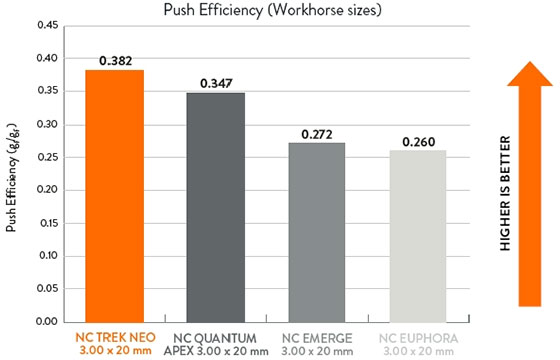
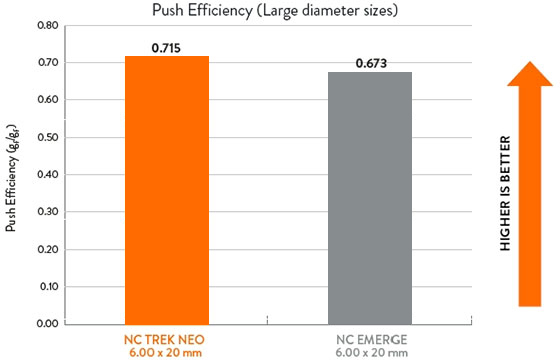
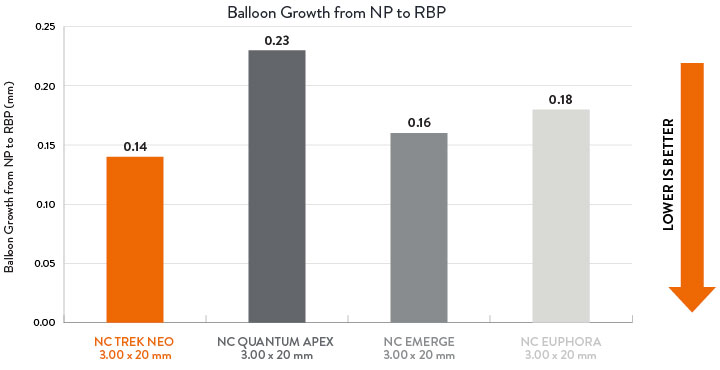
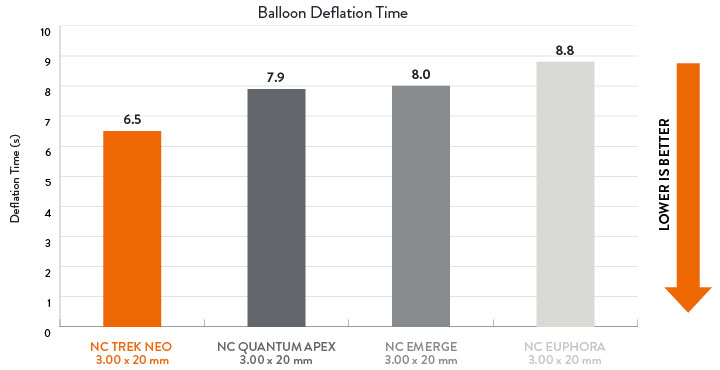
| NC TREK NEO™ Coronary Dilatation Catheter | |
|---|---|
| Platform | Rapid Exchange (RX) |
| Balloon Material | Pebax‡ (1.50 - 5.00 mm Ø) Grilamid (5.50 - 6.00 mm Ø) |
| Marker Material | Flexible Tungsten/Pebax‡ |
| Tip Length | 2 – 3 mm (1.50 - 3.25 mm Ø) 3 – 4 mm (3.50 - 6.00 mm Ø) |
| Distal Coating | Hydrophilic |
| Distal Shaft Diameter | 2.7 Fr (1.50-5.00 mm Ø) 2.8 Fr (5.50 And 6.00 mm Ø) |
| Proximal Shaft Diameter | 2.1 French |
| Compliance | Non-compliant, measured by radial growth mm/(atm or kPa) |
| Nominal Pressure (NP) | 12 atm (1.50-5.00 mm Ø) and 14 atm (5.50-6.00 mm Ø) |
| Rated Burst Pressure (RBP) | 18 atm |
| Catheter Shaft Length | 145 cm |
| Maximum Guide Wire Compatibility | 0.014 inch |
| Latex Free | Yes |
| Shelf Life | 36 months |
| Tip Entry Profile | 0.020 inch maximum |
| Balloon Crossing Profile | 0.028 inch (2.00 mm Ø) 0.036 inch (3.00 mm Ø) 0.051 inch (5.00 mm Ø) 0.050 inch (6.00 mm Ø) |
| Minimum Guiding Catheter ID | 1.50 - 4.00 mm Ø: 5 Fr 4.50 - 6.00 mm Ø: 6 Fr |
| Balloon Diameter (mm) | Balloon Length (mm) | ||||||
|---|---|---|---|---|---|---|---|
| 6 | 8 | 12 | 15 | 20 | 25 | ||
| NC TREK NEO™ | 1.50 | 1400150-06 | 1400150-08 | 1400150-12 | 1400150-15 | 1400150-20 | - |
| 2.00 | 1400200-06 | 1400200-08 | 1400200-12 | 1400200-15 | 1400200-20 | - | |
| 2.25 | 1400225-06 | 1400225-08 | 1400225-12 | 1400225-15 | 1400225-20 | - | |
| 2.50 | 1400250-06 | 1400250-08 | 1400250-12 | 1400250-15 | 1400250-20 | 1400250-25 | |
| 2.75 | 1400275-06 | 1400275-08 | 1400275-12 | 1400275-15 | 1400275-20 | - | |
| 3.00 | 1400300-06 | 1400300-08 | 1400300-12 | 1400300-15 | 1400300-20 | 1400300-25 | |
| 3.25 | 1400325-06 | 1400325-08 | 1400325-12 | 1400325-15 | 1400325-20 | - | |
| 3.50 | 1400350-06 | 1400350-08 | 1400350-12 | 1400350-15 | 1400350-20 | 1400350-25 | |
| 3.75 | - | 1400375-08 | 1400375-12 | 1400375-15 | 1400375-20 | - | |
| 4.00 | - | 1400400-08 | 1400400-12 | 1400400-15 | 1400400-20 | - | |
| 4.50 | - | 1400450-08 | 1400450-12 | 1400450-15 | 1400450-20 | - | |
| 5.00 | - | 1400500-08 | 1400500-12 | 1400500-15 | 1400500-20 | - | |
| 5.50 | - | - | 1400550-12 | 1400550-15 | 1400550-20 | - | |
| 6.00 | - | - | 1400600-12 | 1400600-15 | 1400600-20 | - | |
| Inflation Pressure (atm / kpa) | Balloon Diameter (mm) | |||||||||||||
|---|---|---|---|---|---|---|---|---|---|---|---|---|---|---|
| 1.50 | 2.00 | 2.25 | 2.50 | 2.75 | 3.00 | 3.25 | 3.50 | 3.75 | 4.00 | 4.50 | 5.00 | 5.50 | 6.00 | |
| 2 / 203 | 1.36 | 1.75 | 1.97 | 2.11 | 2.34 | 2.52 | 2.74 | 2.99 | 3.21 | 3.35 | 3.76 | 4.25 | 4.59 | 4.95 |
| 3 / 204 | 1.37 | 1.78 | 1.99 | 2.19 | 2.38 | 2.58 | 2.84 | 3.05 | 3.29 | 3.45 | 3.87 | 4.35 | 4.67 | 5.06 |
| 4 / 405 | 1.38 | 1.81 | 2.02 | 2.22 | 2.43 | 2.63 | 2.89 | 3.11 | 3.35 | 3.52 | 3.93 | 4.43 | 4.75 | 5.15 |
| 5 / 507 | 1.39 | 1.84 | 2.04 | 2.26 | 2.47 | 2.68 | 2.95 | 3.18 | 3.41 | 3.59 | 3.99 | 4.50 | 4.83 | 5.25 |
| 6 / 608 | 1.41 | 1.87 | 2.09 | 2.30 | 2.51 | 2.73 | 3.01 | 3.23 | 3.47 | 3.65 | 4.06 | 4.58 | 4.93 | 5.36 |
| 7 / 709 | 1.42 | 1.90 | 2.13 | 2.34 | 2.55 | 2.78 | 3.06 | 3.29 | 3.53 | 3.71 | 4.13 | 4.66 | 5.02 | 5.46 |
| 8 / 811 | 1.43 | 1.93 | 2.16 | 2.38 | 2.58 | 2.83 | 3.10 | 3.34 | 3.59 | 3.77 | 4.20 | 4.73 | 5.12 | 5.57 |
| 9 / 912 | 1.45 | 1.95 | 2.19 | 2.42 | 2.63 | 2.87 | 3.15 | 3.37 | 3.63 | 3.83 | 4.26 | 4.80 | 5.21 | 5.66 |
| 10 / 1013 | 1.46 | 1.98 | 2.22 | 2.45 | 2.66 | 2.91 | 3.16 | 3.42 | 3.67 | 3.87 | 4.32 | 4.86 | 5.29 | 5.75 |
| 11 / 1115 | 1.47 | 2.00 | 2.24 | 2.48 | 2.69 | 2.94 | 3.23 | 3.46 | 3.71 | 3.91 | 4.37 | 4.91 | 5.37 | 5.83 |
| 12 / 1216 (NP) | 1.49 | 2.01 | 2.26 | 2.50 | 2.71 | 2.97 | 3.26 | 3.49 | 3.74 | 3.95 | 4.41 | 4.96 | 5.43 | 5.89 |
| 13 / 1317 | 1.50 | 2.03 | 2.28 | 2.53 | 2.73 | 3.00 | 3.28 | 3.51 | 3.77 | 3.98 | 4.45 | 5.00 | 5.48 | 5.95 |
| 14 / 1419 (NP) | 1.51 | 2.04 | 2.30 | 2.55 | 2.76 | 3.02 | 3.31 | 3.54 | 3.80 | 4.01 | 4.49 | 5.04 | 5.53 | 6.00 |
| 15 / 1520 | 1.52 | 2.06 | 2.32 | 2.57 | 2.78 | 3.04 | 3.34 | 3.57 | 3.82 | 4.04 | 4.53 | 5.08 | 5.57 | 6.05 |
| 16 / 1620 | 1.53 | 2.07 | 2.33 | 2.59 | 2.79 | 3.07 | 3.36 | 3.60 | 3.85 | 4.07 | 4.57 | 5.12 | 5.61 | 6.09 |
| 17 / 1723 | 1.53 | 2.09 | 2.35 | 2.62 | 2.82 | 3.09 | 3.39 | 3.62 | 3.88 | 4.10 | 4.60 | 5.16 | 5.65 | 6.14 |
| 18 / 1824 (RBP) | 1.54 | 2.10 | 2.37 | 2.64 | 2.84 | 3.11 | 3.41 | 3.65 | 3.91 | 4.13 | 4.64 | 5.20 | 5.70 | 6.18 |
| 19 / 1925 | 1.55 | 2.12 | 2.39 | 2.67 | 2.86 | 3.14 | 3.44 | 3.68 | 3.93 | 4.16 | 4.68 | 5.24 | 5.74 | 6.22 |
| 20 / 2027 | 1.56 | 2.13 | 2.41 | 2.69 | 2.88 | 3.16 | 3.47 | 3.71 | 3.96 | 4.19 | 4.72 | 5.28 | 5.77 | 6.26 |
| Nominal Pressure (NP) | Rated Burst Pressure (RBP) |
*Available on 3.5 - 5.0 mm balloon sizes.
Data on file at Abbott.
MAT-2209296 v2.0

The NC TREK NEO™ Coronary Dilatation Catheters are indicated for:
a) balloon dilatation of the stenotic portion of a coronary artery or bypass graft stenosis, for the purpose of improving myocardial perfusion
b) balloon dilatation of a coronary artery occlusion, for the purpose of restoring coronary flow in patients with ST-segment elevation myocardial infarction
c) balloon dilatation of a stent after implantation (balloon models 2.00 mm – 5.00 mm only)
The NC TREK NEO™ Coronary Dilatation Catheter is contraindicated for treatment of the unprotected left main coronary artery and for coronary artery spasm in the absence of a significant stenosis
This device is intended for one time use only. DO NOT resterilize and / or reuse it, as this can compromise device performance and increase the risk of cross contamination due to inappropriate reprocessing.
Note the “Use by” date specified on the package.
The outside diameter (OD) of the distal 38 cm of the device, including the distal shaft, tip, and the balloon are coated with HYDROCOAT™ Hydrophilic Coating. Refer to PREPARATIONS FOR USE section of these instructions for further information on how to prepare and use this device to ensure it performs as intended. Failure to abide by the warnings in this labeling might result in damage to the device coating, which may necessitate intervention or result in serious adverse events.
Percutaneous transluminal coronary angioplasty (PTCA) should only be performed at centers where emergency coronary artery bypass graft surgery is available.
PTCA in patients who are not acceptable candidates for coronary artery bypass graft surgery requires careful consideration, including possible hemodynamic support during PTCA, as treatment of this patient population carries special risk.
Persons with known history of allergies to any of the components of this device listed below may suffer an allergic reaction to this coronary dilatation catheter. Prior to its use on the patient, the patient should be counseled on the materials contained in the device, and a thorough history of allergies must be discussed. This device contains: polyethylene oxide coating, polyamide, polyether block amide (PEBAX), polyethylene and stainless steel.
Use only the appropriate balloon inflation media. Do not use air or any gaseous medium to inflate the balloon. If gaseous medium is used and balloon rupture occurs there is a potential of causing air embolism and / or vessel injury. Balloon pressure should not exceed the rated burst pressure (RBP). Use of a pressure-monitoring device is recommended to prevent over pressurization.
To reduce the potential for vessel damage, the inflated diameter of the balloon should approximate the diameter of the normal or undiseased vessel segment, just proximal and distal to the stenosis.
Do not use or attempt to straighten a catheter if the shaft has become bent or kinked; this may result in the shaft breaking. Instead, prepare a new catheter.
Treatment of moderately or heavily calcified lesions is considered to be moderate risk, with increase in the risk of acute closure, vessel trauma, balloon burst, balloon entrapment, and associated complications. If resistance is felt, determine the cause before proceeding.
Continuing to advance or retract the catheter while under resistance may result in damage to the vessels and / or damage / separation of the catheter.
When the catheter is exposed to the vascular system, it should be manipulated while under high quality fluoroscopic observation. Do not advance or retract the catheter unless the balloon is fully deflated under vacuum. If resistance is met during manipulation, determine the cause of the resistance before proceeding.
Do not torque the catheter more than one (1) full turn.
In the event of catheter damage / separation, retrieval methods (use of additional wires, snares, and / or forceps) may result in additional trauma to the coronary vasculature and / or the vascular access site. Complications may include bleeding, hematoma, or pseudoaneurysm.
To confirm sterility has been maintained, ensure that the package sterile barrier has not been opened or damaged prior to use. Inspect all product and ensure that the device is not damaged. Care must be taken to properly size the balloon prior to use.
During the procedure, appropriate anticoagulant and coronary vasodilator therapy must be provided to the patient as needed. Anticoagulant therapy should be continued for a period of time as determined by the physician after the procedure.
If the surface of the coronary dilatation catheter becomes dry, wet with heparinized normal saline to reactivate the coating.
Do not reinsert the coronary dilatation catheter into the coil dispenser after procedural use
The safety and effectiveness of these devices have not been established, or is unknown, in vascular regions other than those specifically indicated:
Possible adverse effects include, but are not limited to, the following:
MAT-2206959 v3.0
STAY CONNECTED